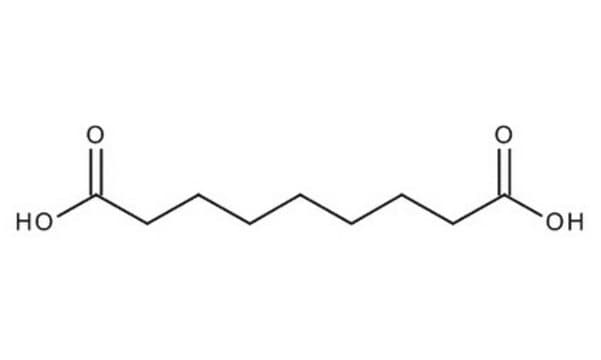Products may be shipped at a different temperature than the recommended long-term storage temperature. If the product quality is sensitive to short-term exposure to conditions other than the recommended long-term storage, it will be shipped on wet or dry-ice. If the product quality is NOT affected by short-term exposure to conditions other than the recommended long-term storage, it will be shipped at ambient temperature. As shipping routes are configured for minimum transit times, shipping at ambient temperature helps control shipping costs for our customers. For more information, please refer to the Storage and Transport Conditions document: https://www.sigmaaldrich.com/deepweb/assets/sigmaaldrich/marketing/global/documents/316/622/storage-transport-conditions-mk.pdf
246379
Azelaic acid
98%
Synonyme(s) :
Nonanedioic acid
Sélectionner une taille de conditionnement
64,10 €
Sélectionner une taille de conditionnement
About This Item
64,10 €
Produits recommandés
Densité de vapeur
6.5 (vs air)
Niveau de qualité
Pression de vapeur
<1 mmHg ( 20 °C)
Essai
98%
Forme
powder
pb
286 °C/100 mmHg (lit.)
Pf
109-111 °C (lit.)
Chaîne SMILES
OC(=O)CCCCCCCC(O)=O
InChI
1S/C9H16O4/c10-8(11)6-4-2-1-3-5-7-9(12)13/h1-7H2,(H,10,11)(H,12,13)
Clé InChI
BDJRBEYXGGNYIS-UHFFFAOYSA-N
Vous recherchez des produits similaires ? Visite Guide de comparaison des produits
Catégories apparentées
Description générale
Application
- As a bio-based monomer in the development of biodegradable polymers. These polymers are explored for a range of applications, including packaging materials, agricultural films, and other products where biodegradability is a key requirement.
- As a crucial component in the synthesis of biodegradable copolyester plasticizers for PVC applications.
- As a monomer in the synthesizing poly(glycerol azelaic acid) for tissue engineering applications. Its contributions to biocompatibility, mechanical properties, degradation behavior, and hydrophilicity make it an essential building block for developing advanced biomaterials aimed at enhancing tissue regeneration processes. In drug delivery systems, azelaic acid may play a role in the synthesis of polymers or other compounds used in drug delivery, potentially enhancing medication effectiveness through improved solubility or stability.
- In skincare products.
Mention d'avertissement
Warning
Mentions de danger
Conseils de prudence
Classification des risques
Eye Irrit. 2 - Skin Irrit. 2
Code de la classe de stockage
11 - Combustible Solids
Classe de danger pour l'eau (WGK)
WGK 1
Point d'éclair (°F)
410.0 °F - closed cup
Point d'éclair (°C)
210 °C - closed cup
Équipement de protection individuelle
Eyeshields, Gloves, type N95 (US)
Faites votre choix parmi les versions les plus récentes :
Déjà en possession de ce produit ?
Retrouvez la documentation relative aux produits que vous avez récemment achetés dans la Bibliothèque de documents.
Les clients ont également consulté
-
How is shipping temperature determined? And how is it related to the product storage temperature?
1 answer-
Helpful?
-
-
How can I determine the shelf life / expiration / retest date of this product?
1 answer-
If this product has an expiration or retest date, it will be shown on the Certificate of Analysis (COA, CofA). If there is no retest or expiration date listed on the product's COA, we do not have suitable stability data to determine a shelf life. For these products, the only date on the COA will be the release date; a retest, expiration, or use-by-date will not be displayed.
For all products, we recommend handling per defined conditions as printed in our product literature and website product descriptions. We recommend that products should be routinely inspected by customers to ensure they perform as expected.
For products without retest or expiration dates, our standard warranty of 1 year from the date of shipment is applicable.
For more information, please refer to the Product Dating Information document: https://www.sigmaaldrich.com/deepweb/assets/sigmaaldrich/marketing/global/documents/449/386/product-dating-information-mk.pdfHelpful?
-
Active Filters
Notre équipe de scientifiques dispose d'une expérience dans tous les secteurs de la recherche, notamment en sciences de la vie, science des matériaux, synthèse chimique, chromatographie, analyse et dans de nombreux autres domaines..
Contacter notre Service technique








